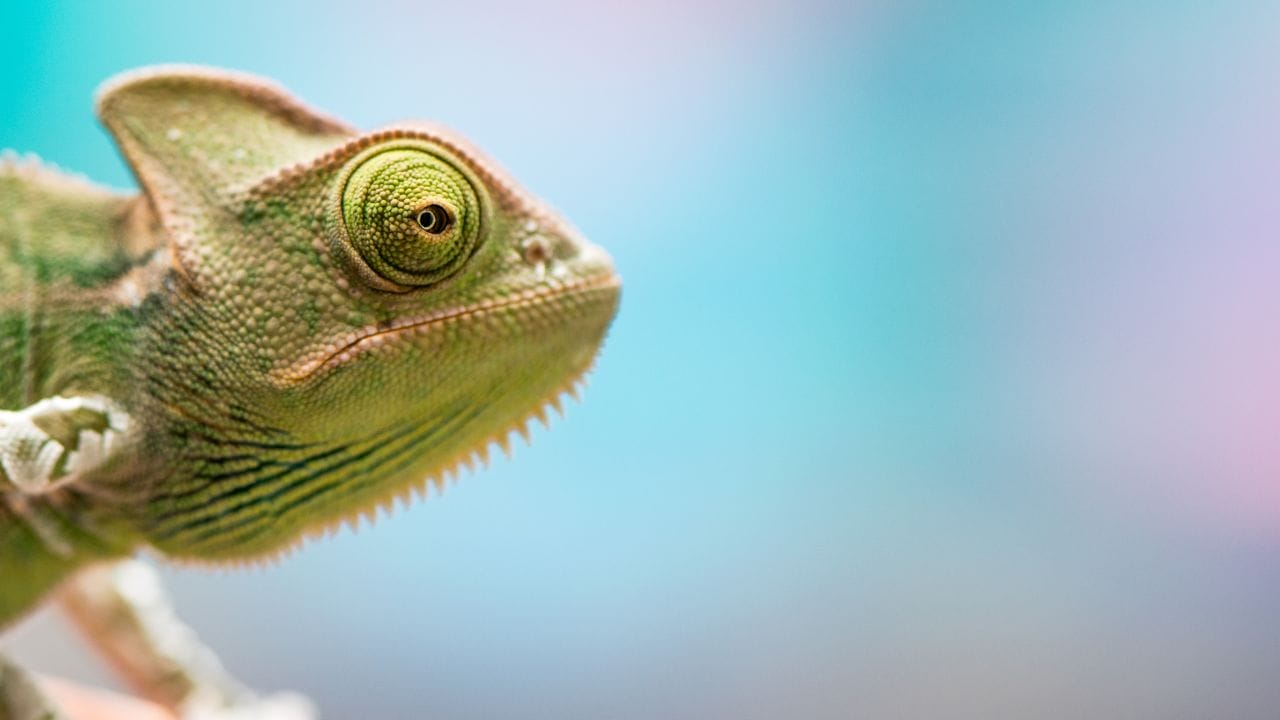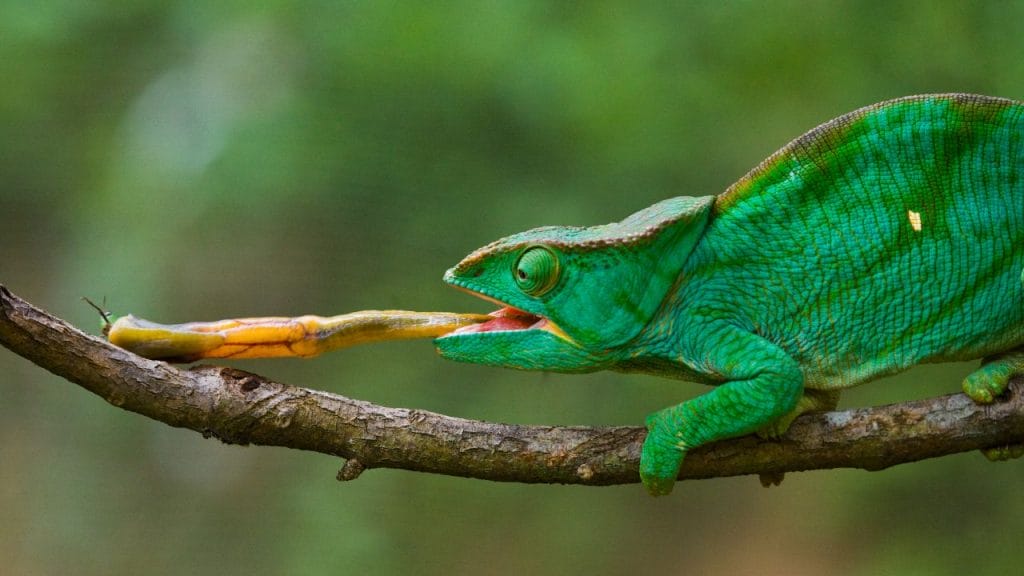Why Is My Chameleon Turning White?

If you’re fortunate enough to call yourself an owner of a chameleon, then we’re quite sure that you’ve been lucky enough to see how incredible they are at changing colors. But here, we’re talking about bright colors, not white or any paler color, right? Now the question is, what if they start turning white or pale all of a sudden?
Turning white is quite normal for chameleons, and that usually happens due to one of two reasons – shedding and changes in temperature. By the way, it’s nothing difficult to rectify.
But is there any possibility that it can be a sign of something bad happening to the lizard? And what if the color turns pale when there are no signs of the above-mentioned reasons? Well, let’s just scroll a bit down and try finding an answer.
Why Does a Chameleon Turn White Or Pale?
Every change you’d see in a chameleon is backed by a reason. But if you’re asking for the reason behind a cham turning white, then there are three to be specific and they are –
Shedding
While getting older, chameleons get rid of their old skin in order to get the new one. This process is what we call shedding. When it comes to shedding frequency, younger chams shed skin more often compared to older ones.
Actually, juveniles and babies shed their skin within a time span of 3-4 weeks. On the other hand, the frequency is once in two months for the adult chameleons. This is the time when you’d see the flakes of their white skin all over their body.
There’s nothing much to worry about the flakes. They’ll fall off, whether with or without the help of the owner. If you’re seeing your lizard shedding, you don’t need to do much but just scrape away the old skin. But make sure that you’re doing it gently. Otherwise, you might end up hurting the lizard.
So, the white or pale color you’re thinking about right now can be a pre-stage of shedding. Don’t be surprised if the reptile refuses to eat during this period of time as it’s quite normal. The white color is simply an indication of upcoming shedding, nothing more than that.
Usually, shedding doesn’t take more than one day to be completed. Even sometimes, it can be done within a few hours. But that’s only for juveniles and babies. The adult might need three days to get over with the shedding.
High Temperatures
When the temperature goes too high, there’s a chance of a cham turning white or pale. As the chameleons are cold-blooded, they always depend on external heat sources to keep their body active and warm. Clearly, their body’s proper functionality depends on the external temperature to a huge extent.
But once the temperature goes too high, the possibility of different health issues starts to pop up. And once they cham is not happy with the temperature, they might let you know that through their white or paler skin color.
The logic is quite simple. When the surrounding gets too cold for the cham, they try to absorb additional heat by dressing up in a darker color and we all know how darker color attracts more heat.
In the same way, when there’s too much heat around, the cham goes for a lighter color and sometimes white or pale to release the additional heat.
Variation in Color Phase
A pale color is not always the indication of a chameleon getting sick. If you’ve owned the cham for a while, then you should know that these reptiles go through a variation in their color phases and this can be one of those as well.
It’s quite normal for chams to turn into a white or paler color when they’re getting ready for their next shedding. So, you can, in a sense, call it another color phase of these reptiles.
No expert or vet so far has agreed to the fact that paler colors are the sole sign of sickness. Sometimes it’s all about developing their adult colors too. So, if you’re still confused about the health issue, then look out for the other common signs related to sickness. If you’re not seeing anything like those, then feel free to count your cham as healthy.
What Does It Mean When A Chameleon Turns White?
If you’re in all those chameleon owner’s forums, you might see a whole bunch of them asking the same question – ‘why my chameleon is turning white or pale?’. This clearly shows that lots of the cham owners are still unaware of the fact and sometimes even get scared as they don’t know if it’s some kind of sickness or what.
We bet, most of them will be convinced with the answer that their chams turn white whenever it’s time for the reptile to leave the skin. After all, the flakes will give their skin a whitish vibe before getting rid of the old skin.
At the same time, they need to keep in mind that, if the enclosure is delivering too much heat, it might turn white or pale. That’s because like the way they try to attract heat with darker colors when they get cold, in the same way, they try reflecting off the excessive heat. This is why the reptile vets suggest ensuring a proper heating system for chams.
But what if it’s sticking too long with the white hue? Well, that’s when it’s okay to worry about the health of the chameleon. There’s a chance of it suffering from dehydration.
It can also be caused by a skin condition. Things here can go so bad that the reptile might not be able to shed skin completely. So, if you’re seeing the cham is turning white permanently, then you should give your vet a call as soon as you can.
By the way, it’s not that always the whole body will turn white. Sometimes you might see it around the chameleon’s mouth or nostrils. If you’re feeling like it’s becoming permanent there, you still should consult the vet. Before being sure about the condition, don’t count it as an indication of a deteriorating health condition.

What Should You Do If the Chameleon is Turning White?
Well, getting worried about your lizard while seeing them all white can surely trigger tension. We don’t blame you for that as that’s quite normal among pet owners. But is there nothing you can do about that? Well, there are a bunch of things you can try like –
Adjusting the Humidity
Every type of chameleon needs a certain level of humidity around. So, know first what kind of humidity your type is asking for. Usually, that level of humidity sticks to a range of 65% to 85%. The good news is achieving the desired level of humidity is way easier than you think.
You can try misting first. All you have to do is misting the cage as per the expert’s instruction. Misting twice should be enough to bring the humidity back to a tolerable level.
Another thing you can do is minimize the enclosure’s airflow. You can use aluminum foil that can cover up the top screen and put the humidity back to the desired level. Adding live plants is also a great idea to adjust the humidity. It’ll give the enclosure more of a natural vibe as well.
In case you often get confused about the humidity level, try using a digital hygrometer. Make sure that it comes with a remote waterproof probe. This setup will make it easier for you to monitor the current humidity level every now and then.
Ensuring Optimum Temperatures
As we told you before, the whitish or pale color might not always be caused by shedding. Sometimes excessive heat makes them go for a paler color so that they can reflect the heat.
And guess what? If the temperature goes too down, the cham can still look paler sometimes. So, the best thing you can do is ensure optimum temperatures. Make sure that you’re always keeping an eye on that number. What you can do is keep a digital thermometer around.
The best temperature for reptiles like chameleons is 72ºF to 80ºF. So, try to stick to that number all the time. Also, make sure that you’re securing a basking area for the lizard as they need that for soaking up UV light. After all, they can’t process their calcium absorption without that.
When it comes to basking temperatures, you better hold it within the range of 85ºF to 95ºF. But don’t forget that on the basis of the chameleon’s species, the required temperature can vary.
How to Know if the White Color isn’t Triggered by Shedding?
Are you seeing any white flakes? Isn’t the white color temporary? Well, if the answer to both of these questions has come ‘No’, then the chance is quite high of the chameleon being sick.
There are a bunch of colors the cham can dress up with and almost all of them are bright. But the last time we checked, we didn’t see pale, ashen, or white colors weren’t on that list.
We’ve already told you before that the white color is a temporary thing for the chams. But when the time is catching a duration like days, then it’s okay if you doubt the color as a sign of sickness. But the white color is never the sole sign of sickness. So, you can only be sure if it’s backed by other common signs as well.
If you’re noticing those signs, then feel free to give your vet a call. Now the question is, what are the other signs that should be worried about? Well, here’s the list.
Dehydration
If the reptile is not shedding but still looking paler, then one of the common signs you’re going to see is probably dehydration. You can identify dehydration by examining the fecal matter. A hydrated chameleon’s fecal matter will be white for sure. But once the dehydration hits, it’ll become orange or yellow.
Low Body Temperature
Another common sign of a sick chameleon is an imbalance in its body temperature. Usually, it goes down in such cases. Also, getting insufficient UVB rays too can play a vital role here.
Malnutrition
You’ll see the sign of malnutrition in a sick lizard. Actually, when these reptiles get sick, they don’t feel like eating, and missing the meal leads to malnutrition. And guess what? Lack of nutrition can mess with the ability to keep up with healthy colors.
What Can You Do to Help?
There’s no way to deny that chameleons are among the most delicate reptiles. So, getting a hit from different diseases is nothing unexpected for them. But when you’re seeing signs of sickness combined with symptoms like paler color, then there are a bunch of things you can do to make things better.
The first thing you can do here is to make sure that you’re boosting up the moisture level. Keeping the reptile hydrated really important to let it go back to its natural color. If misting twice a day is not being enough, try increasing the misting sessions or try prolonging the sessions.
Also, ensure that the reptile is getting enough water to drink. If the misting is not covering the leaves properly, then try spraying water over there separately so that the lizard can take its sips from there.
Try to give it a nutritious meal, filled with calcium of course. And also keep the temperature on point. If after doing all these, the reptile is showing no sign of improvement, meet your vet as that’s your last resort.
Final Words
Having a white chameleon might sound like fun, but that’s always not the case. If it’s triggered by issues like shedding, then you can simply lean back and enjoy seeing the process. But if the other symptoms are popping up that you see when the cham gets sick, then you better talk to the vet as soon as you can.
About Author
Hello, I’m Muntaseer Rahman, the owner of AcuarioPets.com. I’m passionate about aquarium pets like shrimps, snails, crabs, and crayfish. I’ve created this website to share my expertise and help you provide better care for these amazing pets.
Disclaimer
This site is owned and operated by Muntaseer Rahman. AcuarioPets.com is a participant in the Amazon Services LLC Associates Program, an affiliate advertising program designed to provide a means for sites to earn advertising fees by advertising and linking to Amazon.com. This site also participates in other affiliate programs and is compensated for referring traffic and business to these companies.

